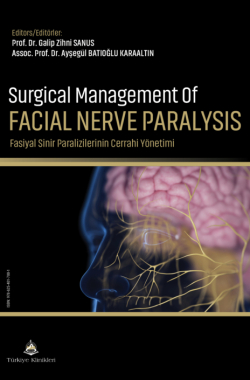Functional Serratus Anterior Muscle Transplantation to Improve Smile in Long-Standing Facial Paralysis
Levent YOLERİa, Yavuz TULUYb
aManisa Celal Bayar University Faculty of Medicine, Department of Plastic, Reconstructive and Aesthetic Surgery, Manisa, Türkiye
bTurgutlu State Hospital, Clinic of Plastic, Reconstructive and Aesthetic Surgery, Manisa, Türkiye
Yoleri L, Tuluy Y. Functional serratus anterior muscle transplantation to improve smile in long-standing facial paralysis. In: Sanus GZ, Batıoğlu Karaaltın A, eds. Surgical Management of Facial Nerve Paralysis. 1st ed. Ankara: Türkiye Klinikleri; 2022. p.219-24.
ABSTRACT
The loss of cheek tonus, facial asymmetry at rest, drooling and inability to smile are problems that are needed to be solved in patients with facial paralysis. In long-standing facial paralysis, free functional muscle transfer with cross-facial nerve grafting is a preferred dynamic reconstructive procedure. Different types of muscles are used for this purpose. The senior author prefers to use the last three slips of serratus anterior muscle. Three slips can be inset in different vectors, so imitation of the facial muscles can be ensured. The distance between the root of the helix and modiolus is measured preoperatively on the healthy side. This distance is a reference for eighth slip. The other seventh and ninth slips are designed according to eight slip. The other muscle flaps need intramuscular dissection to inset at different vectors. Also thin serratus muscle slips with long and constant neurovascular pedicle can be better than the other donor muscles.
Keywords: Facial paralysis; cross-facial nerve grafting; serratus anterior muscle
Kaynak Göster
Referanslar
- Conley j, Baker DC. The surgical treatment of extratemporal facial paralysis: an overview. Head Neck Surg. 1978;1(1):12-23. [Crossref] [PubMed]
- Cooper TM, McMahon B, Lex C, Lenert jj, johnson PC. Cross-facial nerve grafting for facial reanimation: effect on normal hemiface motion. j Reconstr Microsurg. 1996;12(2):99-103. [Crossref] [PubMed]
- Scaramella LF. Cross-face facial nerve anastomosis: historical notes. Ear Nose Throat j. 1996;75(6):343, 347-52, 354. [Crossref]
- Fisch U. Cross-face grafting in facial paralysis. Arch Otolaryngol. 1976;102(8):453-7. [Crossref] [PubMed]
- Thompson N. A review of autogenous skeletal muscle grafts and their clinical applications. Clin Plast Surg. 1974;1(3):349-403. [Crossref] [PubMed]
- Harii K, Ohmori K, Torii S. Free gracilis muscle transplantation, with microneurovascular anastomoses for the treatment of facial paralysis. A preliminary report. Plast Reconstr Surg. 1976;57(2):133-43. [Crossref] [PubMed]
- Vu P, Guedon C, Gehanno P, Andreassian B. Anatomic basis of serratus anterior muscle flap transposition. Surg Radiol Anat. 1988;10(3):173- 85. [Crossref] [PubMed]
- Mclaughlin CR. Surgical support in permanent facial paralysis. Plast Reconstr Surg (1946). 1953;11(4):302-14. [Crossref] [PubMed]
- Whitney TM, Buncke Hj, Alpert BS, Buncke GM, Lineaweaver WC. The serratus anterior free-muscle flap: experience with 100 consecutive cases. Plast Reconstr Surg. 1990;86(3):481-90; discussion 491. [Crossref]
- Yoleri L. Modification of tension on muscle insertion improves smile in free-muscle transplantation. Ann Plast Surg. 2006;57(3):295-9. [Crossref] [PubMed]
- Frey M, Giovanoli P. The three-stage concept to optimize the results of microsurgical reanimation of the paralyzed face. Clin Plast Surg. 2002;29(4):461-82. [Crossref] [PubMed]
- Ferguson LD, Paterson T, Ramsay F, Arrol K, Dabernig j, Shaw-Dunn j, et al. Applied anatomy of the latissimus dorsi free flap for refinement in one-stage facial reanimation. j Plast Reconstr Aesthet Surg. 2011;64(11):1417-23. [Crossref] [PubMed]
- Harrison DH. The pectoralis minor vascularized muscle graft for the treatment of unilateral facial palsy. Plast Reconstr Surg. 1985;75(2):206-16. [Crossref] [PubMed]
- Park Dj, Chung jH, Baek SO, Kim jW, Hwang NH, Yoon ES, et al. Intraoral temporalis transposition for facial reanimation: A novel technique in facial nerve palsy. j Craniomaxillofac Surg. 2020;48(3):235-41. [Crossref] [PubMed]
- Yoleri L, Güngör M, Usluer A, Celik D. Tension adjusted multivectorial static suspension with plantaris tendon in facial paralysis. j Craniofac Surg. 2013;24(3):896-9. [Crossref] [PubMed]
- Rubin LR. The anatomy of a smile: its importance in the treatment of facial paralysis. Plast Reconstr Surg. 1974;53(4):384-7. [Crossref] [PubMed]
- Biglioli F, Colombo V, Tarabbia F, Pedrazzoli M, Battista V, Giovanditto F, et al. Double innervation in free-flap surgery for long-standing facial paralysis. j Plast Reconstr Aesthet Surg. 2012;65(10):1343-9. [Crossref] [PubMed]
- Bae YC, Zuker RM, Manktelow RT, Wade S. A comparison of commissure excursion following gracilis muscle transplantation for facial paralysis using a cross-face nerve graft versus the motor nerve to the masseter nerve. Plast Reconstr Surg. 2006;117(7):2407-13. [Crossref] [PubMed]
- Baccarani A, Starnoni M, Zaccaria G, Anesi A, Benanti E, Spaggiari A, et al. Obturator nerve split for gracilis free-flap double reinnervation in facial paralysis. Plast Reconstr Surg Glob Open. 2019;7(6):e2106. [Crossref] [PubMed] [PMC]
- Koshima I, Umeda N, Handa T, Moriguchi T, Orita Y. A double-muscle transfer using a divided rectus femoris muscle for facial-paralysis reconstruction. j Reconstr Microsurg. 1997;13(3):157-62. [Crossref] [PubMed]
- Vedung S, Hakelius L, Stâlberg E. Cross-face nerve grafting followed by free muscle transplantation in young patients with long- standing facial paralysis. Scandinavian journal of Plastic and Reconstructive Surgery. 1984;18(2):201-8. [Crossref] [PubMed]
- O'Brien BM, Franklin jD, Morrison WA. Cross-facial nerve grafts and microneurovascular free muscle transfer for long established facial palsy. Br j Plast Surg. 1980;33(2):202-15. [Crossref] [PubMed]
- Terzis jK, Noah ME. Analysis of 100 cases of free-muscle transplantation for facial paralysis. Plast Reconstr Surg. 1997;99(7):1905-21. [Crossref] [PubMed]

